Technology based practices in water conservation and saving
1. Sri Lanka: Foot operated water valve
Being an agricultural based economy, Sri Lanka has a high water requirement. Addition to this, water resources have become prominent sources in industry, supply of services, recreation activities, hydro power generation and daily needs such as drinking, bathing etc. Over 80 percent surface water is utilized by the irrigation and agriculture sectors in the country. There are gaps in demand and supply in the provision of water for irrigation and drinking purposes due to geographical and temporal variability.
Sri Lanka is well endowed with water resources. However, about two thirds of the island is considered as dry, and faces seasonal shortages and recurring droughts. A relatively high percentage of precipitation is converted to runoff as over 90% of the island is underlain by crystalline rocks of low permeability. Almost all the streams and rivers are seasonal streams and seasonal water scarcities are frequent and can be very severe. The rainfall is usually confined to just a few months (October-January) leading to flooding in those months due to almost flat terrain. Bed rock is closer to the earth surface resulting in shallow water table and water retaining capacity of soil is also low in the country.
The need for intervention through water conservation practices was thus recognized and so, in order to address water shortage issue, there has been introduction of new devices and appurtenances for water conservation in the country. Foot operated water valve developed by NERDC (National Engineering Research and Development Center) is one such example of a simple device for water conservation.
The new generation valves are adopted in all public installations in the country. These are operated by foot and contains a complete unit fixed to the floor where the wash basin is fixed. The water lines of the tap are connected through this unit.
Source: Fernando, W.J.L.S., Challenges, Technological and Policy Interventions for sustainability of Water in Sri Lanka, NERD Centre, Sri Lanka
This new innovation has many advantages as it helps in saving water by 58% compared to the hand operated water valve. It is user friendly design with easy operation where both hands are free for cleaning while operating the tap and there is no requirement of alternative power sources to operate. The device is easy to install and does not require heavy modifications for fixing location. It can easily control the water flow rate as per the operator’s requirement and has no effects on human health. It has got an ergonomical design which is highly durable and requires less maintenance.
Related: The new water technologies that could save the planet
2. Iran: Bowl shaped roofs collect rainwater and cools house
Iran is on the fast track to severe water scarcity as the semi-arid country faces an onslaught of threats to its water supply, including population growth, mass migration, political instability and resource mismanagement. Water scarcity in Iran is due to both physical as well as economic water scarcity.
Changes in water availability are reflected in the country’s physical geography. Lake Urmia, once the largest Salt Lake in the Middle East, has shrunk to 5 percent of its previous size. Other waterways across the country have run dry as well. Illegal wells, plus heavy agricultural use, are also depleting groundwater.
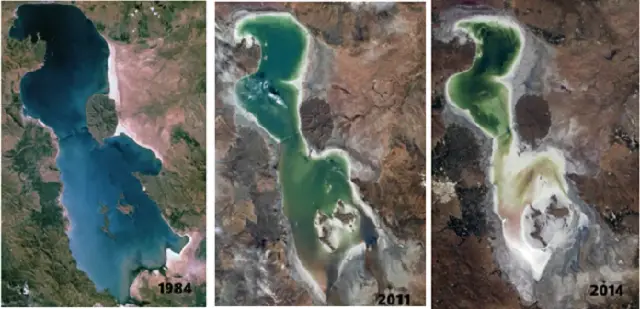
Source: Wikipedia, Urmia lake drought as cited from NASA
According to the head of the Iranian Environment Department, Issa Kalantari (2017) if water consumption for agriculture continues to remain at the present level then Iran’s eastern and southern areas will be completely deserted in less than 25 years and 50 million people will have to emigrate. In less than 50 years, country’s residents have used about 30 per cent of the groundwater which took millions of years to gather. Currently, 70 percent of Iranians live in urban areas. In future, 80 percent are expected to live in cities. Adding more residents would increase pressure on the urban areas where water use already is excessive. The city’s per capita water use exceeds 400 liters each day, compared with a country wide average of 250 liters per day. Tehran, which is the capital and largest city, could soon be the epicenter of the country’s water crisis because if the current trend continues, the city’s water demand is estimated to be 1290 million cubic meters (MCM) per year by 2026. At that level, the city’s supply would be an estimated 100 MCM below demand in dry years.
In order to address the water crisis problem, an attempt has been made by an Iranian Architecture company to help conserve water at building level through an unconventional roof design that would collect rainwater and help in cooling the house i.e., the new bowl-shaped roof serves a double purpose for people living in hot, arid climates – providing free water and free air conditioning. The concave roof is designed in such a way that even the smallest quantities of rain flow down the roof and eventually coalesce into bigger drops, just right for harvesting before they evaporate.
The shape of the roof is not only perfect for maximizing water collection but also for providing shade and airflow between itself and the interior layer of roof, helping keep the house below cool. Other than this, the bowl roof also provides a second cooling feature. The water it collects is stored in tanks in the walls of the house, cooling the walls and insulating the house.
The company is working on a school building as a prototype, which is expected to be able to collect and store over 7000 gallons of water with 10,000 sq.ft. of rooftop. Once successful, this concept will help in providing water security in a part of the world that receives less than a third of the global average for
annual rainfall.
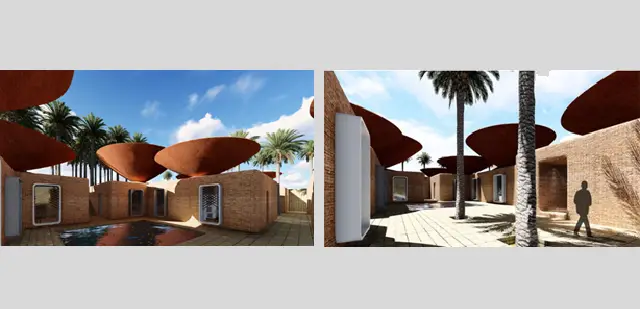
Source: Burrows, S. (2019) Bowl-Shaped Roofs Collect rainwater and Cool House
3. South Africa: Water map in Cape Town
South Africa is a semi-arid country, with rainfall being seasonal and unevenly distributed. It experiences a rainfall average of less than 500 mm/ year, compared to a global average of 869 mm, compared to a global average of 869 mm, making it the 30th driest country in the world. (Friedrich et al, 2009 as cited in Madonsela, 2019: 292) Water resources in South African cities have increasingly come under pressure due to climate change and rapid urbanization. Increasing water demand is also putting pressure on water resources in South African cities. A recent (2015-2018) country wide drought resulted in severe water shortages in many parts of South Africa, most notably affecting the Western Cape province and the City of Cape Town.
The Cape Town region experiences a Mediterranean climate with warm, dry summers and winter rainfall. The city water supply system relies almost entirely on rainfall, which is captured and stored in six major dams situated in mountainous areas. These dams are recharged by rain falling in the catchment area largely during winter months and dams level decline during the dry summer months during which urban water use increases and irrigation takes place. The two main uses of water in the city are urban and agricultural, consuming approximately 70 per cent and 30 per cent respectively of the total water supplied by the water supply system.
In January 2018, at the height of the Cape Town drought crisis, a behavioral change web- based tool named Water Map was introduced to encourage water conservation. The main purpose of the web-map was to publicly acknowledge or reward households that saved water, thereby normalizing and incentivizing water conservation behavior.
The City Water Map was launched to make a dent in the 2,00,000 homes going over the limits imposed by the city on usage. The limit was tightened to 87 litres per person for a family of four to push day zero back which was further reduced to 50 litres a day per person for a family of four. The water map’s landing page in the website provides a bird’s eye view of the city of Cape Town municipality, as it appears on Google Maps. Zooming in to individual properties reveals the address with street and plot number as well as water usage level. The plots of users who are within the water restriction limit are marked with a green dot.
The map applies a theory developed by the University of California in 2015 that households will drastically reduce their water use when they realize they are the odd one out in a water-saving neighborhood.
The water map was updated during the third week of every month and showed the following information:
- Water use per household (free-standing houses only; not cluster housing, flats or other land uses)
- Collection points for treated effluent (recycled wastewater) for industry and construction
- Water distribution zones, used to supply water and manage water pressure.
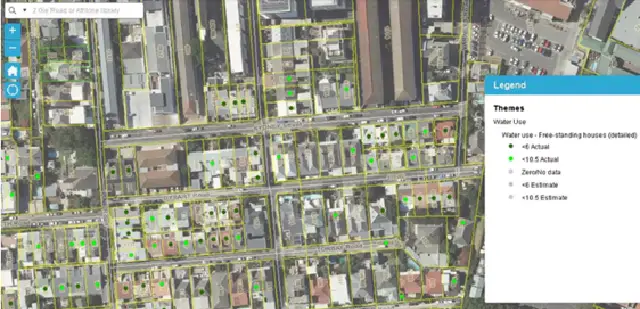
Source: Water Map, Cape Town Government
The strength of the Water Map I sits potential to apply social pressure to encourage water savings. Social pressure exerts a powerful influence and shapes behavior of the people. By allowing the public gaze to fall on every residential property in the municipality, the Water Map renders home publicly accountable for their water usage. As, water conservation is a combined effort, without this accountability, it is not possible to achieve the objective. Hence, accountability of water usage by the residents is used as an important instrument in this Water Map.
4. Egypt: Desalination of brackish and seawater
Water resources in Egypt are becoming scarce as the surface water resources originating from the Nile are currently fully exploited, while groundwater sources are being brought into full production. Egypt is facing increasing water needs, demanded by rapidly growing population, increased urbanization, higher standards of living and expanding agricultural production to feed growing population. The population of the country is currently increasing by more than one million persons a year. With a population of approximately 74 million in 2008, the population is expected to see an increase to about 100 million by 2025. The most critical constraint that the country is facing is the growing shortage of water resources along with the deterioration of water quality. (Abdin et al., 2009: 12)
Per capita fresh water availability in Egypt reduced from 1893 cubic meters in 1959 to 900-950 cubic meters in 2000 and tends to decline further to 670 cubic meter by 2017 and 536 by 2025 (Abd-El-Hai, 2002 as cited in Abdin et al., 2009). The main reason behind this rapid fall is the fixed water resources available and the rising pressure due to population growth.
The Nile river is considered the main source of water in Egypt where its water covers about 96% out of the total water requirements of the country and the rest is covered by the available groundwater, the rain falling on the northern coastal areas and potential desalination of sea and brackish water. (Rayan et al., 2004: 654).
In order to meet the rising water demand for freshwater, desalination of brackish water and sea water is the potential water source in Egypt which can cater to this increasing requirement. Desalination in Egypt started some twenty years ago for drinking water supply to coastal towns and in the petroleum and energy sector. Egypt has a long shoreline of about 2,450 km on both the Mediterranean and the Red Sea. Desalination of water is being practiced in Egypt in some locations along the Mediterranean coast, the Red coast, and in the north and south Sinai.
Desalination is a treatment process that removes salts from water. Saline solutions other than sea water are typically described as brackish water with a salt concentration from 1,000 pp to 11,000 ppm TDS. Normal sea water has a salinity of 35,000 ppm TDS. Salt concentration in the Mediterranean waters is about 35,000 mg/l, while in the Red Sea it is about 40,000 mg/l.
Most of the old installations are evaporation plants but in recent years, a large number of RO plant and ED plants have become operational in different economic sectors. The desalination capacity in Egypt has grown to some 150,000 cubic meter per day in 1999 which was 1,00,000 cubic meter per day in 1996. The capacity of individual plants is generally small and ranged between 500 and 10,000 cubic meter per day. There are about 230 desalination units in Egypt with a total capacity of 220,000 cubic meter per day. (MWRI, 2005 as cited in Abdin et al., 2009).
Desalination of seawater and brackish water in Egypt has turned out to be a major alternative water source as the river Nile water is fixed and limited in quantity. Also, over pumping is increasing salinity of the abstracted groundwater and over withdrawal of drainage water leads to deteriorating the quality of mixed water. Therefore, the need of desalination is essential to have good quality water.
5. Jordan: Greywater treatment using septic tanks and reuse for home gardens in Tufileh
Jordan is one of the ten most water scarce countries in the world. It is a small land locked country in the Middle East with water resources that are characterized by “scarcity, variability and uncertainty” (AL-JAYYOUSI, 2002). Annual precipitation varies with location in the country; the northwest receiving approximately 600mm/y and the eastern and southern deserts, which form about 91% of the surface area, receiving less than 200 mm/y (AL-JAYYOUSI, 2003). Evaporation is estimated at about 90% (AL-JAYYOUSI, 2002).
Jordan’s population is approximately 5.7 million with a growth rate of 2.7% (IDRC, 2006b). In 2015, approximately 80% population lived in urban areas which had greatly threatened the food and water security of the poor, who increasingly found themselves in towns and cities. Due to high population growth over twenty years, per capita water availability is less in the country. Jordan is at a deficit in terms of the natural water supply which is met by mining non-renewable groundwater. The average per capita water consumption is 120 liters per capita per day including garden irrigation (AL-BEIRUTI, 2006). Poor households use less water, approximately 50 liters per capita per day (AL-JAYYOUSI, 2002). Residents in the capital city, Amman, receive on average less than 100 liters per capita per day of drinking water, delivered altogether only on 1 or 2 days a week (AL-JAYYOUSI, 2003). To address the problems of water scarcity in Jordan, the use of fresh water resources has been prioritized depending on its social and economic value whichever is highest: for drinking and domestic purpose.
In order to address the issues of water scarcity of the peri-urban poor, the authorities investigated participatory water management solutions on a local level and communities had shown willingness to input time and energy to utilize greywater in their home gardens, empowering the poor to take responsibility for addressing their own food and water insecurity.
This greywater reuse project in Tufileh, Jordan provided a revolving fund to help poor peri-urban families recover household greywater to grow fruits and vegetables. The system of greywater treatment involves two stages: pre-treatment takes place in a storage tank (160 l barrel) with a greywater kit. The tank acts as a conventional septic tank which removes oil, grease and settable solids. Secondary stage involves a collective treatment.
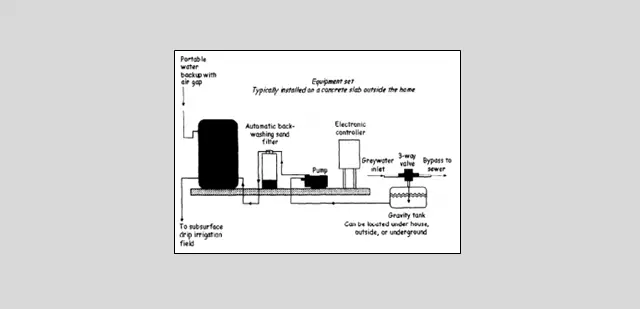
Source: Imhof, B. & Mühlemann, J. (2005) Greywater treatment on household level in developing countries – A state of the art review
This project helped families conserve valuable freshwater, achieve greater food security and generate income through sales of produce. Moreover, it has led to minimization of the environmental impact arising from the use of untreated greywater.
6. India: Water conservation by reducing huge steam wastage and recycling used steam in a cement industry in Rajasthan
Ultra Tech Cement Ltd. in Kotputli, Rajasthan is a cement works power plant which recognized the need for intervention because of the cement plant load fluctuations which result in a lot of steam venting from the boiler to maintain the load on Thermal Power Plant (TPP). There was a huge steam wastage earlier in the industry which resulted in wastage of water, chemicals and heat. The intervention was made to prevent the wastage of water and other materials. It involved the Dump system refurbishment being done and a logic incorporated in the system. During load fluctuations, complete steam is taken into the dump valve and the same gets condensate through Air Cooled Condenser (ACC), which is then recycled into the boiler. Hence, there was a recovery of the complete system venting.
This intervention led to reduction of demineralized (DM) water consumption by 48 kl per day and resulted in power saving of Rs. 2.45 lac/year by avoiding multiple pumping. This initiative helped in complete recovery of steam venting along with the conservation of water. It also ensured considerable reduction in energy consumption due to recycle of water.

Source: NITI Aayog (2017) Selected Best Practices in Water Management
7. Brazil: Car wash wastewater reclamation in Porto Alegre
Brazil has a large population of 207 million people. While the access to safe water has increased since 2010, there are still some inequalities that prevail due to varying geographical regions. Currently there are five million people without access to safe water (water.org). Even though Brazil has historically been blessed with an abundant supply of water, droughts and floods have reached and made an impact on major part of the Brazilian population. The water crisis had an uneven regional impact in the country as in the northeast, many rivers are in a critical condition due to scanty rainfall and high evapotranspiration; in the southeast, there is a high demand for water supplemented by severe water pollution; there is insecurity of water supply in the metropolitan area due to high demand; in the south, there is high water stress due to heavy demand for irrigation of rice; and in the Federal District, there is a combination of lack of rain and high demand.
Water crisis in Brazil is a result of a combination of local, regional and global causes that have led to changes in the rainfall, river flows and water cycle. The most important local cause which affected the availability of water is intense pumping of groundwater for various uses, especially irrigation on the other one is deforestation which has impacted the water cycle. Other than these, uncontrolled urbanization, dumping of waste and sewage in rivers, development of aquifer recharge areas etc. have substantially led to water scarcity.
There are various conservation practices exercised in the country to cope with the water related issues. One such is the car wash wastewater reclamation initiative taken up in the car wash industry in Porto Alegre, South Brazil. Reclaimed (reuse, recycling) water is defined as the wastewater that has gone through various treatment processes to meet the specific water quality criteria – fit for purpose principle (Metcalf and Eddy, 2006 as cited in Zaneti et al., 2011). According to Brown (2000), car was wastewater reclamation requires the separation of grit, oil and greases prior to be reused.
In Porto Alegre, car wash wastewater reclamation system was installed in a washrack where a single three stage oil/water separator was employed after car wash pit to comply with local regulations. Reclaimed water, fresh water and total water usage were monitored using single-jet water meters and in the was procedure, a neutral and alkali detergent were employed. Following image depicts the procedure involved.
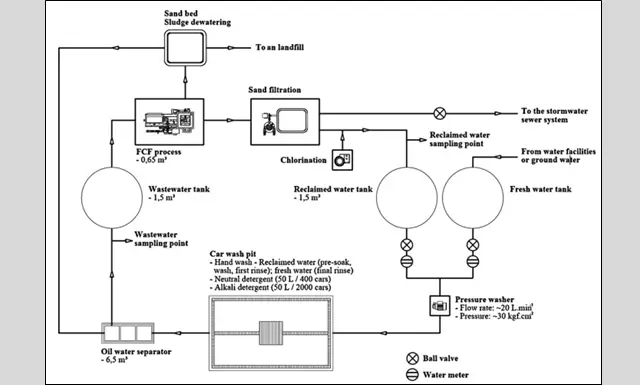
Source: Zaneti, R., Etchepare, R. & Rubio, J. (2011) Car wash wastewater reclamation. Full-scale application and upcoming features, Resources, Conservation and Recycling, Vol.55, pp.953-959
Reclaimed water was employed in three stages – pre-soak, wash and first rinse. Fresh water was used only in the final rinse, before the cars being dried. Using FCF (Flocculation Column Flotation), sand filtration and chlorination, almost 70% of odorless and clear water was reclaimed.
8. India: Use of Ambient air during winter season for water conservation in Maharashtra
This initiative was taken and implemented by Mahindra automobile Industry in Nashik, Maharashtra. The project was focused on the optimization and conservation of water resources. In any automobile plant, painting is the most water intensive unit contributing to about 55% of plant’s water consumption followed by the cooling process. To supply the conditioned air in the painting process, air suppliers are provided, which work through a process of heat developed by gas operated burners and cooling by water humidifiers. Thus, three important required resources figured out in the industry in this particular process are – Water, gas and power.
After studying the consumption pattern, process requirements and human comfort requirements, the team thought that there is a potential to conserve all three resources and specifically water, during winter season when ambient temperature is on the lower side itself. Therefore, the innovative idea of using low temperature ambient air directly without conditioning for non-spray booth areas during winter season was implemented.
This practice helped in reducing water consumption drastically by reducing average water consumption to 643 KL which was 846 KL initially. Along with the water conservation, this initiative also had a positive impact on the Gas and Power consumption.
Reference
- Fernando, W.J.L.S., Challenges, Technological and Policy Interventions for sustainability of Water in Sri Lanka, NERD Centre, Sri Lanka
- Burrows, S. (2019) Bowl-Shaped Roofs Collect rainwater and Cool House, As retrieved from https://returntonow.net/2019/06/22/bowl-shaped-roofs-collect-rainwater-and-cool-house/
- Madonssela, B. et al. (2019) Evaluation of Water Governance Processes Required to Transition toward water Sensitive Urban Design – An Indicator Assessment Approach for the City of Cape Town, Water, Vol.11(2), pp. 292
- Water Map, Cape Town, As retrieved from https://www.capetown.gov.za/Family%20and%20home/Residential-utility-services/Residential-water-and-sanitation-services/cape-town-water-map
- Abdin A.E., Gaafar I. Rational water use in Egypt. In : El Moujabber M. (ed.), Mandi L. (ed.), TrisorioLiuzzi G. (ed.), Martín I. (ed.), Rabi A. (ed.), Rodríguez R. (ed.). Technological perspectives for rational use of water resources in the Mediterranean region. Bari : CIHEAM, 2009. p. 11-27 (Options Méditerranéennes : Série A. Séminaires Méditerranéens; n. 88)
- Brown, M. (2019) Protecting Africa’s Troubled Waters: Using nature to improve water security in Africa’s fast-growing cities, The Nature Conservancy
- Rayan, M.A., Djebedjian, B. & Khaled, I. (2004) Evaluation of the effectiveness and performance of Desalination Equipment in Egypt, Eighth International Water Technology Conference, IWTC8 2004, Alexandria, Egypt
- Imhof, B. & Mühlemann, J. (2005) Greywater treatment on household level in developing countries – A state of the art review
- NITI Aayog (2017) Selected Best Practices in Water Management., As retrieved from https://niti.gov.in/writereaddata/files/document_publication/BestPractices-in-Water-Management.pdf
- Zaneti, R., Etchepare, R. & Rubio, J. (2011) Car wash wastewater reclamation. Full-scale application and upcoming features, Resources, Conservation and Recycling, Vol.55, pp.953-959
Related